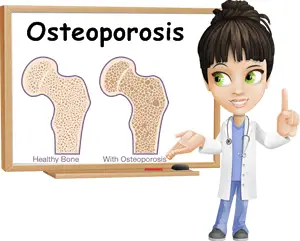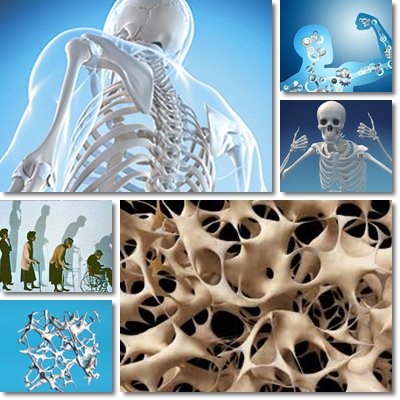Osteoporosis, the disease that causes our bones to become more porous, brittle and fragile, significantly increasing our risk of fractures, is silent.
Most sufferers are not aware of the fragile condition their bones are in up until they suffer a fracture. And although this is a slow progressing disease, there are usually no telling signs to indicate its onset. Generally, the most affected categories are women and the elderly.
However, osteoporosis has been found to occur in teenagers and children as well, although cases like this are extremely rare. Lack of physical exercise to strengthen bones, poor diet and prolonged use of certain medication are the main modifiable factors that contribute to low bone density and increase the risk of developing the disease.

What does a bone with osteoporosis look like?
As mentioned above, osteoporosis is a disease that causes our bones to become brittle and predisposed to fractures. Our bones, which are made of collagen and minerals such as calcium, have to be quite dense to support movement, especially bipedalism, which puts quite a lot of strain on them. But in osteoporosis, they start losing some of their density or mass which leads to low bone mineral density.
Low bone mineral density is when our bones become porous, the degree of degradation depending on how low bone density is.
A bone with osteoporosis, as you can see in the image above, will look a lot like a honeycomb, full of holes or cavities. This means that when under strain, it stands a higher chance to break and produce a fracture.
Osteoporosis causes are diverse, but generally, a change in diet, prevention of vitamin and mineral deficiencies, exercising and taking special medication are the recommended actions for most sufferers.
(Signs and symptoms) Osteoporosis
Osteoporosis in itself is a non-symptomatic disease. Generally, the first observable sign of it is a bone fracture. However, there are some signs and symptoms that can indicate the progression of the disease prior to a bone fracture:
1) Backache accompanied by noticeable pain.
2) Stooped posture.
3) Loss in height as a result of the stooped posture.
4) Pain in general.
These symptoms are not specific and can easily have other causes, hence the difficulty in diagnosing the disease before it wreaks havoc. Actually, one of the main reasons people shrink with age is osteoporosis. This shrinking is often disregarded, but it can be a sign of the disease.

Types of osteoporosis
There are different types of osteoporosis, depending on the age of the sufferer and these are:
1) Primary osteoporosis. This is the most common type and affects both men and women over a certain age. Its causes are diverse and may range from hormonal problems to poor dietary habits and lack of physical activity.
2) Secondary osteoporosis. This occurs either as a result of another disease (hyperthyroidism, for example) or as a result of the medication taken to treat another disease. Prolonged use of certain medication is known to lead to side effects such as low bone mineral density and increase the risk of osteoporosis.
3) Juvenile osteoporosis. Although rare, this type of osteoporosis affects children during their growth period and may have to do with low bone formation rates or fast bone resorption rates. Any significant growth spurt occurring in between 8 and 18 years of age can trigger osteoporosis onset.
4) Osteogenesis imperfecta. This is also a rare occurrence. It is a type of osteoporosis that appears at birth and causes fragile bones and fractures.
5 Treatment options of osteoporosis
Treatment options for osteoporosis caused by unmodifiable factors include medication, dietary changes and exercise therapy. Osteoporosis caused by modifiable factors can be prevented, to a certain extent, by addressing the risk factors listed above again through exercise, dietary changes, vitamin and mineral supplementation or even medication.
1) Nutrition
Eating right is a crucial part of preventing and managing osteoporosis. It is thus important to include in our diet foods rich in calcium such as yogurt, sesame seeds, goat and cow milk and cheese, liver, spinach, turnip greens, collard greens, sardines, salmon and other fish etc.
Moderate sun exposure to get vitamin D as well as including foods rich in vitamin D into your diet are crucial for proper calcium absorption. Great sources of vitamin D include goat milk, mushrooms, especially shiitake, eggs, salmon, sardines etc.
Phosphorus-rich foods and magnesium-rich foods are further important for bone health.
2) Supplementation
Despite voices saying vitamin and mineral supplements are toxic or ineffective, most people rarely get all the nutrients their body needs over the course of one day and supplements are designed to mimic the exact same biological effects of vitamins and minerals from plant and animal sources.
This being said, for the majority of us, supplementation is pivotal for meeting our body’s nutrient demands and keeping healthy overall.
For magnesium, which is one of the most important nutrients for strong bones, one a lot of people do not get enough of on a daily basis, it’s also important to choose the right form. See my article on magnesium forms and which to choose.
3) Physical exercise
According to research, physical exercise has a great positive impact on bone health and osteoporosis prevention and management. Experts recommend resistance exercises, weight-bearing exercises and flexibility exercises to help build and maintain bone mineral density as our bones grow stronger and more resistant to falls and overall physical strain.
Examples of physical exercises for osteoporosis sufferers include walking, weight lifting to strengthen muscles, yoga, tai chi, certain aerobic exercises, hiking etc.
4) Medication
Generally, medical professionals will recommend either a three year or a five year medication plan for osteoporosis sufferers. Medication such as risedronate, etidronate, alendronate, teriparatide, bisphosphonates etc. are prescribed. This is done after a medical professional has thoroughly evaluated your bone mineral density and diagnosed you with osteoporosis.
But while these types of medication reduce fracture risks, they come with serious side effects such as nausea, diarrhea, headaches, eczema, blood clots, heart attack, pulmonary embolism etc. Also, taking medication alone is not enough and we still have to bring improvements to areas such as diet, lifestyle and exercise regimen.
5) Other lifestyle changes
As mentioned above, osteoporosis prevention and management is linked to several important lifestyle changes. Quitting smoking, significantly reducing alcohol and coffee intake as well as soft drink consumption is pivotal for bone health. For example, while smoking has a negative impact on estrogen metabolism, coffee favors nutrient deficiencies, both of which promote loss of bone mineral density.
